TAHLIA PERRY shows me an extraordinary photograph of an echidna, which is testament to the remarkable resilience of these animals in the face of bushfires. The picture, submitted to her citizen science project EchidnaCSI, shows an animal with its spines severed halfway along their length, giving it the appearance of having been trimmed into a flat-top hairstyle.
“The echidna had this weird thing, where it looked like its spines had been cut, but actually it had been caught in a controlled burn,” explains Tahlia, who is based at the University of Adelaide. “It was a striking image…and our social media went pretty wild.”
Often, rather than attempt to outrun a fire, echidnas simply burrow into the ground, or conceal themselves inside fallen logs. One of their many unique talents is that they can dig straight down on the spot, disappearing into the dirt in as little as a minute. They then enter a temporary hibernation-like state to conserve energy, and wait for the danger to pass.
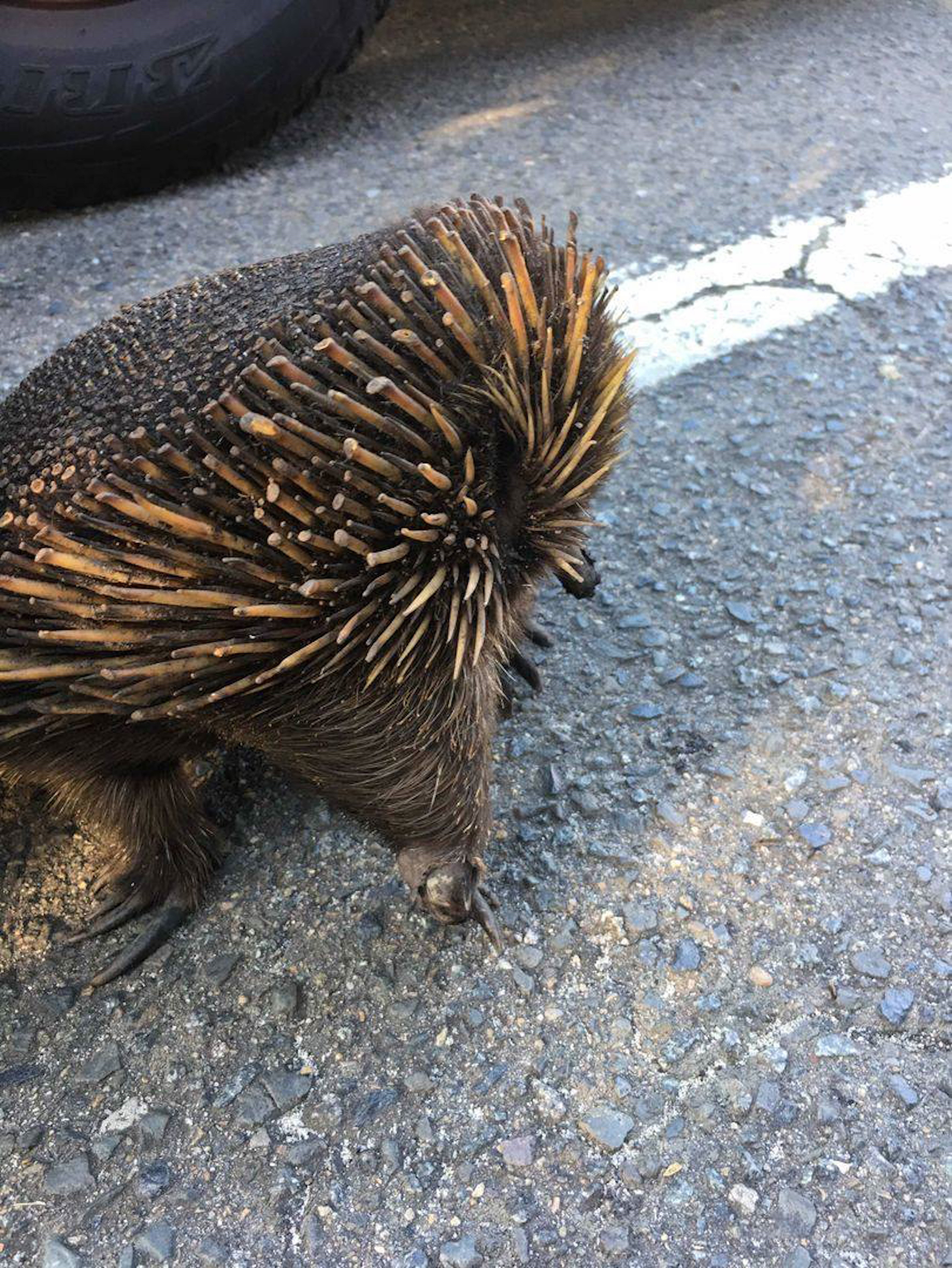
This ‘torpor’, which is also employed by echidnas in some cooler regions, sees them slow their heart rate, metabolism and temperature – breathing in and out as few as three times a minute. On rare occasions they may stay like this for weeks following a fire, only emerging once their insect prey has returned to the environment.
But the echidna in the image, snapped by citizen scientist Georgina Swan following a hazard reduction burn in bush in northern Sydney, clearly hadn’t dug down far enough, and its spines were melted off. Tahlia explains that this might not have been painful for the animal, because the spines, being modified hairs, are not living tissue.
Although that particular image was taken in August last year, just before the catastrophic Black Summer fire season got underway, pictures and reports emerged early this year of echidnas elsewhere with melted spines. In fact, along with wombats, which also take refuge underground, echidnas were some of the most commonly spotted mammal survivors emerging from the ashes of still-smouldering firegrounds.
Dr Peggy Rismiller, who has studied echidnas for 30 years from her base at the Pelican Lagoon Research and Wildlife Centre on Kangaroo Island (KI), says that when the fires blazed across the island in December and January, young echidnas were still in their nursery burrows, but during subsequent surveys she saw a number of them emerge unscathed. Adults dig in and manipulate dirt between their spines for insulation, she explains.
Almost half of KI ultimately burnt, and, although some echidnas were no doubt killed, Peggy has found quite a few that bear no marks of having been through a fire, as well as “others whose spines melted because they didn’t dig deep enough, but they have survived and are continuing their normal lives”.
Under more usual fire conditions, right across Australia echidnas are able to survive better than other mammals. But with the Black Summer fires “being so intense and burning such a large area, we’re unsure how many have survived”, Tahlia says. Nevertheless, given that the platypus and the echidna – both egg-laying monotremes – are creatures that have been around for tens of millions of years, Peggy isn’t surprised they are deft at navigating natural perils, such as bushfires.
Monotremes are the “longest surviving” lineage of mammals, she says. “They were around with the dinosaurs and survived through greenhouse effects and ice ages, and if you’ve been around that long you know what you are doing.”
Found from the wet rainforests of the north, through the arid centre to the alpine uplands of the south-east, the short-beaked echidna is Australia’s most widespread mammal. But perplexingly, its biology was almost completely unknown until about 30 years ago.
Since then, populations on KI and Tasmania have been well studied by Peggy and University of Tasmania Associate Professor Stewart Nicol, unlocking many secrets about these enigmatic creatures. However, the echidnas on the Australian mainland have remained stubbornly elusive, something Tahlia is hoping to change.
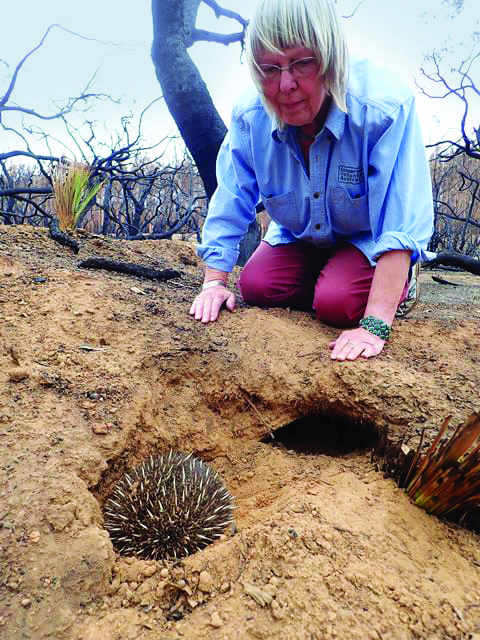
The evolution of the echidna
“Of all the mammalia yet known, it seems the most extraordinary in its conformation,” English zoologist George Shaw wrote of the platypus in 1799. The echidna’s duck-billed cousin typically takes the crown as the world’s weirdest mammal, but Australia’s ‘spiny anteater’ certainly gives it a run for its money.
“Porcupine-like quills, a beak that’s a bit like a cross between a bird and an anteater, a pouch like a marsupial, legs pointing in the direction that no other animal’s legs point: they’ve got this very odd combination of features,” says Jack Ashby, who specialises in Australian mammals and is manager of the University of Cambridge Museum of Zoology in the UK.
As most people who have encountered them in the wild know, echidnas have excellent defensive measures, not least of which is rolling up into a prickly ball to present a formidable and potentially painful challenge to a hungry dingo or wedge-tailed eagle.
When really spooked, an echidna will dig vertically “by shimmying its forelimbs in a way that clears the dirt underneath it, allowing it to drill down into the soil, and then use its claws to lock into roots, pebbles, whatever, so it’s completely impossible to pick up”, Jack explains. “They can also move their spines individually, wedging them into cracks or between rocks, so you can’t lever them out, which is an absolutely amazing predator defence.”
Three long-beaked echidna species in New Guinea, the short-beaked echidna, and the platypus are the only living monotremes. Long-beaked echidnas were once also present in northern Australia, but were thought to have gone extinct here 20,000 years ago. However, a long-beaked echidna pelt recently rediscovered at the Natural History Museum in London with a label noting it was collected in 1901 in Western Australia’s Kimberley, suggests they may have persisted in low numbers until much more recently.
The monotreme lineage branched off from the ancestors of marsupials and placentals (the group to which most living mammals, including humans, belong) perhaps as long ago as 180 million years.
Echidnas therefore retain some fascinating features that were present in early mammals and inherited from our reptilian ancestors. These include egg-laying and a sprawling gait, with legs held out to the sides, like lizards, rather than directly underneath the body as they are in other mammals. That’s why platypuses and echidnas appear to waddle when on land, although this doesn’t stop echidnas trundling along at speed when they need to.
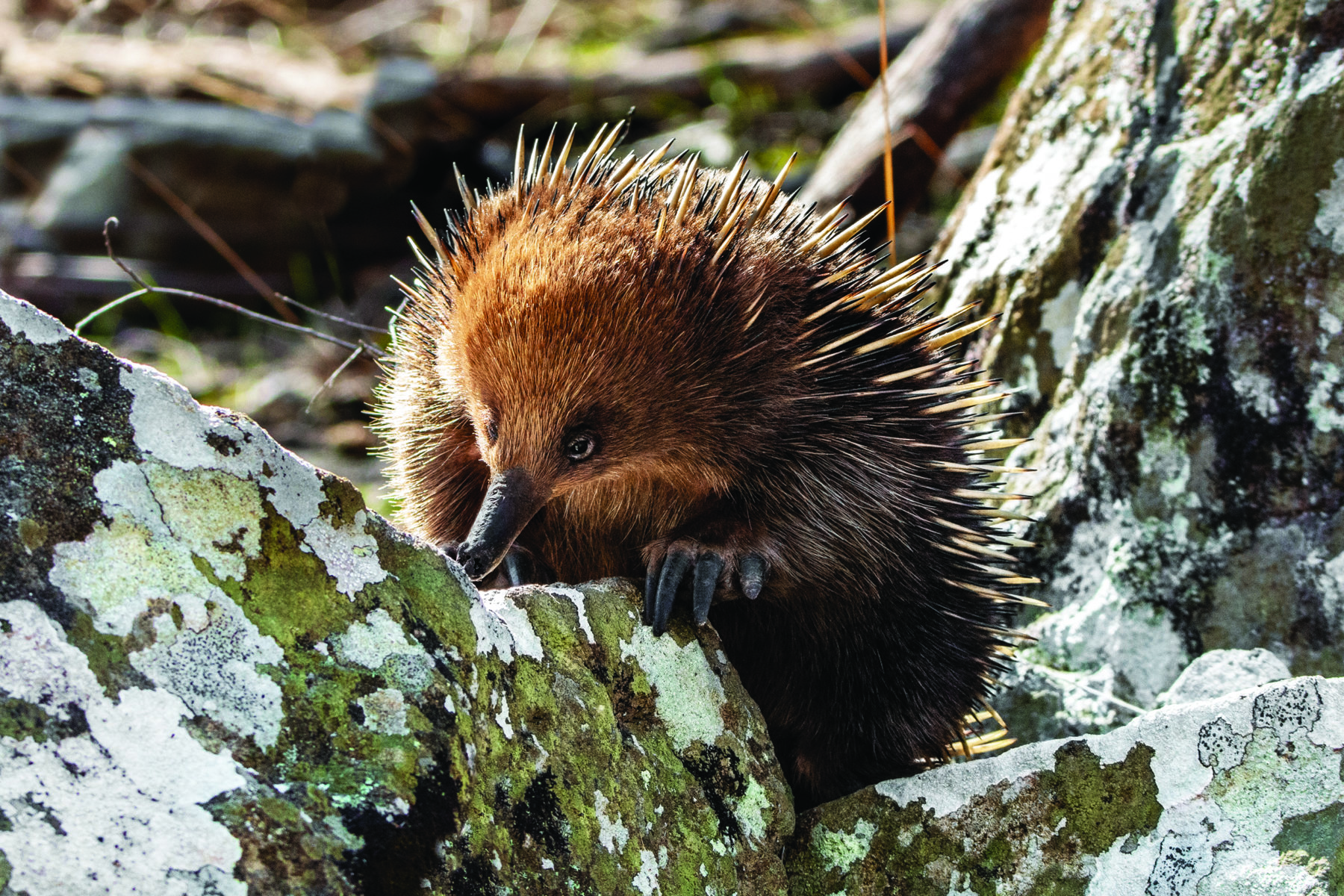
Echidnas probably evolved from platypus-like ancestors more than 20 million years ago. Today, monotremes have the lowest metabolic rate and body temperature of the mammals. An echidnas body temperature typically sits at 31ºC to 33ºC, some 5ºC cooler than humans, although this can fluctuate by 6ºC to 8ºC in a day. In Tasmania, the Australian Alps and other colder parts of its range the species hibernates, at which time its temperature drops to as low as 4ºC.
Echidnas also have many peculiarities all their own, such as the hind feet pointing backwards, for digging, which baffled 19th-century European taxidermists.
“Whenever I’m overseas, I go and see if their stuffed echidnas have got their feet pointing the right way,” Tahlia says. “When people were sending echidnas to museums, they didn’t realise the hind feet point backwards so there’s a whole bunch where the feet have been forced around to point forwards.”
The fact that their limbs are angled out to the sides and they have backwards-pointing feet and long, sickle-like claws, means they have another peculiar physiological trait. “They can reach backwards, around, up and over their backs, so their hind legs can scratch between their shoulders,” Jack says. “It’s very strange to watch; it looks like a complete dislocation.”
After George Shaw scientifically described the short-beaked echidna in 1792, it was another 92 years before anyone realised it was an egg-layer, like the platypus. Peggy says it’s an indication of how difficult echidnas are to study and observe in the wild.
“They are very elusive, secretive, cryptic and not attracted to anything – so basically finding them is being in the right place at the right time,” Peggy says, explaining that just to observe one echidna requires about 300 hours in the field, necessitating a level of tenacity and dedication that few other researchers have been able to muster.
Since 1988 Peggy and thousands of volunteers have logged some 10,000–15,000 hours in the field, locating echidnas and attaching small radio transmitters to them to track their movements. Her decades of work have unravelled the secrets of how echidnas mate and reproduce.
The knowledge gaps
The Echidna Conservation Science Initiative – EchidnaCSI – began in 2017 as a way of collecting data to help understand and conserve echidnas, without having to spend thousands of hours in the field, says Tahlia, who runs it as part of her PhD.
“Echidnas are incredibly difficult to study in the wild: we have surprisingly little data about their populations across Australia,” she explains. Because few people have been prepared to put in the work on the mainland until now, there are huge knowledge gaps about echidna distribution, physiology and ecology.
To remedy this, Tahlia and her Adelaide University supervisor, Professor Frank Grützner, devised the idea of a citizen science app to which people could upload sightings and photos. The data would help build the first detailed echidna distribution map covering all Australia. “People take photos of echidnas whenever they see them, and the app tracks the date, time and location, making everything as automated as possible,” Tahlia says.
Citizen scientists also collect and mail in echidna poo, which Tahlia is studying to build a database of DNA from various regions and to understand the diet and intestinal microbiome of the animal across its across range. Hormone traces could reveal stress levels and whether an echidna is sexually active or pregnant.
The scientists were unsure how people would react to the idea of hunting for echidna scats but “people love collecting poo”, Tahlia says. So far, the project has exceeded all expectations. In just three years, more than 10,000 sightings have been uploaded and eager participants have mailed in at least 400 poo samples – providing more data than it would have been possible for Tahlia and her colleagues to collect in decades working on their own.
“The public are really our saviours,” Tahlia adds. “People love echidnas and we see the passion for their conservation growing exponentially since the beginning of EchidnaCSI.” Frank’s group was involved in sequencing the platypus genome in 2008 and is currently working on mapping the echidna genome. Other projects are looking at monotreme sex chromosomes, sex-determining genes and applications of the genetics of monotremes to understand and treat human diseases, such as cancer and diabetes.
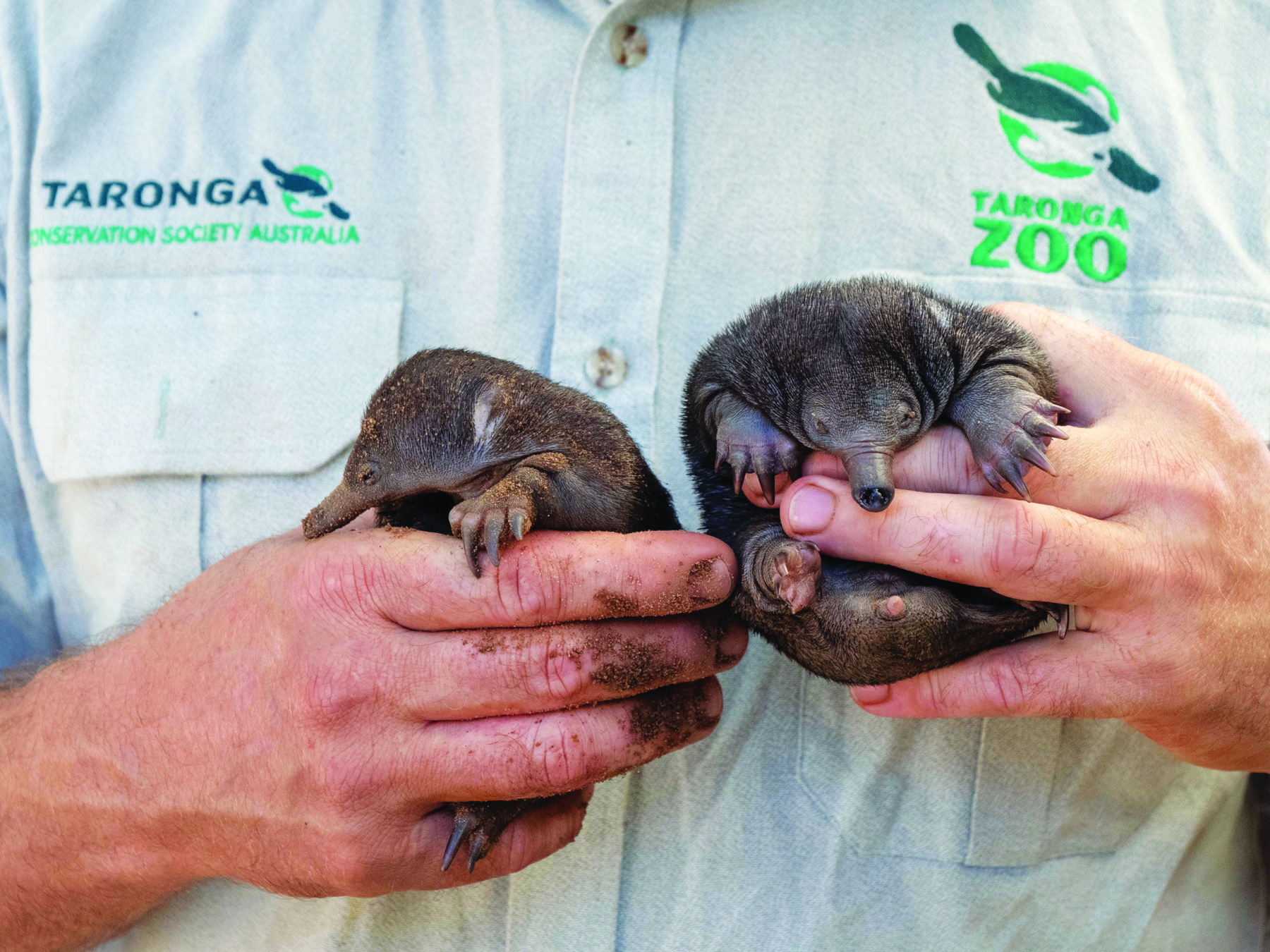
What don’t we know about this animal and how many assumptions have been made?
When Peggy arrived on KI from Germany in 1988, next to nothing was known of basic echidna biology. A young postdoc researcher who’d completed a PhD on reptile physiology, she had half a grant to study tiger snakes and half a grant to study echidnas.
“I thought it was interesting that I could work on an egg-laying mammal and a live-bearing reptile,” she explains, referring to the fact the young of tiger snakes hatch internally.
Echidnas lay their eggs into a temporary infolding of skin – a ‘pseudo-pouch’ – and Peggy’s first job was to find an egg so her Adelaide University supervisor, Professor Roger Seymour, could study its respiration rate.
Peggy had only seen an echidna in a zoo before then. But the challenge of finding and catching one did not deter her. “I love challenges,” she says, and although ending up spending much of her life studying echidnas was an accident, it’s something she’s never regretted. “It was my karma, my good fate.”
At one point in that first year, she and her now partner, Mike McKelvey, who started the Pelican Lagoon Research and Wildlife Centre in the early ’80s, were removing the transmitter from a study subject, when Peggy noticed something odd about the shape of the pseudo-pouch.
“So we unrolled her, and there was a young that had just hatched,” she says. “That was sort of my light bulb going off, saying ‘Good grief, what don’t we know about this animal and how many assumptions have been made?’”
Before that, many people had assumed echidnas incubated and hatched their eggs in burrows, as platypuses do. But Peggy discovered they are laid into and hatch in the pseudo-pouch, which is formed when a female’s abdominal muscles draw in her swollen mammary glands to create an infolding of skin. At that point very few other people had observed newly hatched echidnas, so Peggy was gripped with awe and excitement.
“Unrolling that echidna and seeing the young, which looks like a little blob of jelly was the most amazing experience. The body was translucent, the lungs weren’t functioning yet, but you could see the heart,” she says. “We were able to very carefully remove it, weigh and measure it, and that started me on my way to looking at how echidnas reproduce. It’s just been a fantastic journey.”
An echidna egg is about the diameter of an Australian 5c coin, which happens to bear the image of an echidna, and hatchlings only fill about one-third the space inside that leathery egg. Eight newly hatched echidnas weigh as much as that coin, Peggy says.
Subsequent work showed that echidna hatchlings are almost foetal and respire through their skin for up to four days until their lungs develop. Peggy and Mike also found that on KI females carry their single egg in their pseudo-pouch for 10 days before it hatches, and then the hatchling for another 45–55 days.
Once the babies, known as puggles, begin to develop sharp spines, their mothers dig a nursery burrow for them, where they continue to suckle them for seven months. Females will go out to forage and return only to provide milk for about two hours once every five days, at which time a puggle can take in an incredible 10–40 per cent of its body mass in milk.
A defining trait of all mammals is that they produce milk. But egg-laying monotremes are unlike placental and marsupial mammals (the young of which develop in a womb and a true pouch, respectively), in that they have no teats or nipples.
The milk is instead suckled by the puggles from milk patches on the mother’s abdomen. Because this is a less sterile delivery mechanism than a teat, monotreme milk has remarkable antimicrobial substances, which are now being studied for human medical applications.
July to September is the best time to see echidnas in the wild because these normally solitary animals form ‘echidna trains’, where up to 10 males will follow a female for many weeks hoping to mate with her. Peggy and Roger were the first to observe and document echidnas mating, showing that females will eventually lie flat on their stomachs while the suitors dig a circular trench or ‘mating rut’ around her. Finally, the most dominant male will shove the others out of the way, lie on his side and tuck his tail under her. The pair will then mate cloaca to cloaca.
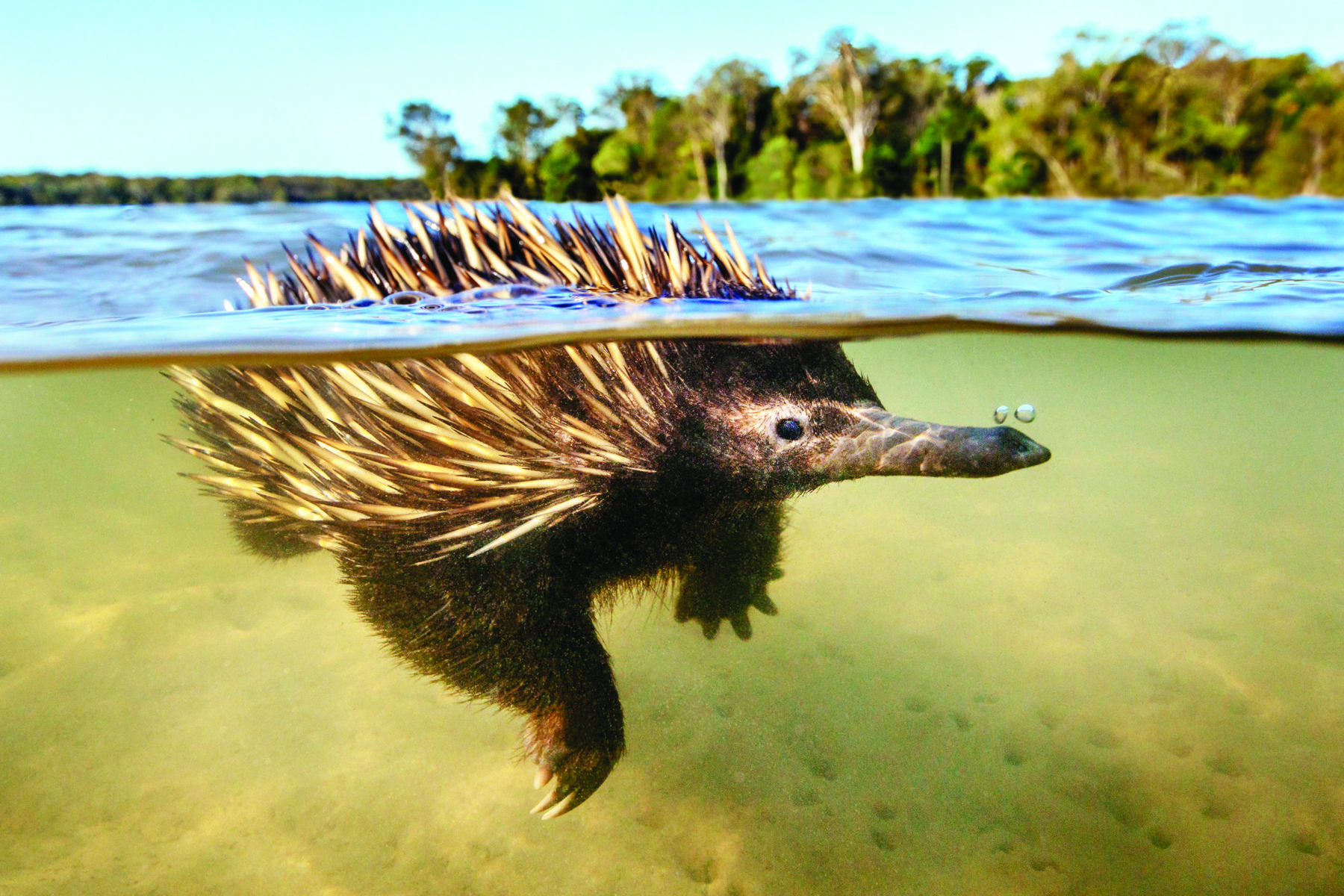
Echidnas disappearing?
If you really want to see echidnas, Peggy says, it’s better going to Tasmania than KI. She has about 40 study subjects over a 1500ha area. But in a similar sized area of Tasmania Stewart Nicol has up to 200. Abundance is just one way in which fluffier-looking Tasmanian echidnas differ to those on KI. Tassie echidnas hibernate for 4–5 months, something not seen on KI or across Australia’s arid zones. Stewart has also documented differences in how they mate, incubate eggs and raise young.
Tasmanian echidnas go into hibernation as early as January – which seems counterintuitive, given this is the warmest time of the year – and emerge to mate in May or June. Males emerge earlier and often seek out and mate with females even before they have fully awoken. Echidnas also hibernate in south-eastern Queensland and on Mt Kosciuszko at exactly the same time. So, rather than being entirely temperature driven, Stewart suspects hibernation is more to do with conserving energy over the period when ants and other invertebrate prey are in shortest supply.
“We really don’t know why they do it,” he says. “It may be something that they need to do. In February–March the overall ecosystem productivity drops off, as things dry out, so I think they are getting less food for the effort during late summer and autumn.”
Presently, the short-beaked echidna is one species comprising five different subspecies. But could there be two species?
Stewart’s latest work suggests there may be two broad kinds of echidna in Australia that have different diets and, as a result, different skull and beak shapes. The echidnas of WA, South Australia, KI and the centre of the continent are generally more arid-zone specialists, and tend to eat more ants and termites.
Those of Tasmania and the east coast eat a much higher proportion of grubs, particularly cockchafer larvae, which are more abundant in those wetter regions. Tahlia’s work on the scats also suggests echidnas take in some plant matter and fungi in addition to invertebrates.
One issue with echidnas being so poorly surveyed and little known on the mainland is there is no way to tell if they are declining. Peggy’s research on the KI subspecies – for which threats include feral cats, vehicle strikes and habitat loss – resulted in it being classified as endangered in 2015.
Because mainland echidnas have been so understudied, they haven’t been seen as facing a conservation risk before, “but those are all the same threats we find across the whole of Australia”, Tahlia says. She hopes EchidnaCSI will continue in the future, “and we can actually see some population trends over time, which we’ve never had the ability to do before”.
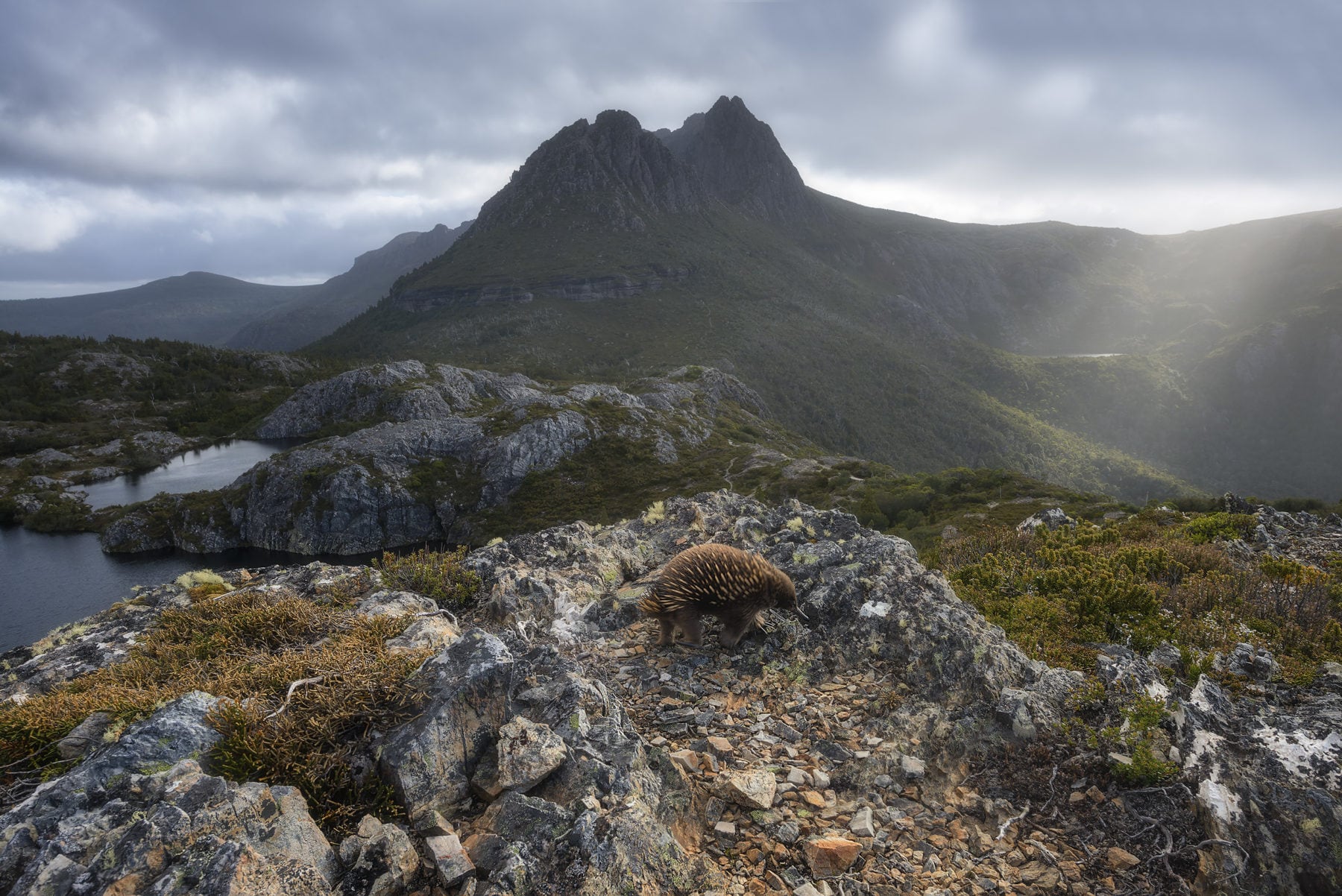
Stewart says that after such a long-running field project, one of his favourite things about studying echidnas is they “live so long that you can follow them for a long time and get to know a particular individual’s personality and behaviour”. Echidnas can live for 50 years or more, comparable to the life-span of an elephant, and an almost inconceivably long time for a small mammal, most of which don’t live beyond a decade.
Peggy also says it’s their sense of personality that sometimes delights her: “Echidnas I think like to have fun. We’ve watched echidnas climbing up on tree branches and then doing somersaults off, just as if they were playing. Echidnas also like to go for a swim, and we get reports about them swimming across dams when they could have just walked around.”
Other stories from the Great Ocean Road tell of people attempting to ‘save’ echidnas from the surf only to watch them head straight back into the ocean again. “They are just an animal that intrigues everyone because they go their own way and do their own thing,” Peggy says.
Australians should know when they encounter an echidna they are “seeing something very, very special”, she adds. “They have been around for so long, but are disappearing, and my biggest concern is that there isn’t enough information about echidnas on the mainland. They’re not considered threatened there, but there are places where they’ve gone extinct… They’re Australia’s most ubiquitous mammal, yet we have really ignored them.”









